Marmot
Marmots are relatively large ground squirrels in the genus Marmota, with 15 species living in Asia, Europe and North America. These herbivores are active during the summer when often found in groups, but are not seen during the winter when they hibernate underground. They are the heaviest members of the squirrel family.[1]
| Marmots Temporal range: Late Miocene – Recent | |
|---|---|
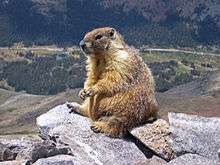 | |
| Yellow-bellied marmot (Marmota flaviventris) | |
| Scientific classification | |
| Kingdom: | Animalia |
| Phylum: | Chordata |
| Class: | Mammalia |
| Order: | Rodentia |
| Family: | Sciuridae |
| Tribe: | Marmotini |
| Genus: | Marmota Blumenbach, 1779 |
| Species | |
|
15, see text | |
Description
Marmots are large rodents with characteristically short but robust legs, enlarged claws well adapted to digging, stout bodies, and large heads and incisors to quickly process a variety of vegetation. While most species are various forms of earthen-hued brown, marmots vary in fur coloration based roughly on their surroundings. Species in more open habitat are more likely to have a paler color while those partially found in well-forested regions tend to be darker.[2][3] Marmots are the heaviest members of the squirrel family. Total length varies typically from about 42 to 72 cm (17 to 28 in) and body mass in the smaller species averages about 2 kg (4 1⁄2 lb) in spring in the smaller species and 8 kg (18 lb) in autumn, at times exceeding 11 kg (24 lb), in the larger species.[4][5][6] The largest and smallest species are not clearly known.[3][4] In North America, based on mean linear dimensions and body masses through the year, the smallest species appears to be the Alaska marmot and the largest is the Olympic marmot.[5][7][8][6] Some species, such as the Himalayan marmot and Tarbagan marmot in Asia appear to attain roughly similar body masses to the Olympic marmot but are not known to reach as high a total length as the Olympic species.[9][10] In the traditional definition of hibernation, the largest marmots are considered the largest "true hibernators" (since larger "hibernators" such as bears do not have the same physiological characteristics as obligate hibernating animals such as assorted rodents, bats and insectivores).[11][12]
Biology
Some species live in mountainous areas, such as the Alps, northern Apennines, Carpathians, Tatras, and Pyrenees in Europe; northwestern Asia; the Rocky Mountains, Black Hills, the Cascade and Pacific Ranges, and the Sierra Nevada in North America; and the Deosai Plateau in Pakistan and Ladakh in India. Other species prefer rough grassland and can be found widely across North America and the Eurasian Steppe. The slightly smaller and more social prairie dog is not classified in the genus Marmota, but in the related genus Cynomys.
Marmots typically live in burrows (often within rockpiles, particularly in the case of the yellow-bellied marmot), and hibernate there through the winter. Most marmots are highly social and use loud whistles to communicate with one another, especially when alarmed.
Marmots mainly eat greens and many types of grasses, berries, lichens, mosses, roots, and flowers.
Subgenera and species
The following is a list of all Marmota species recognized by Thorington and Hoffman[13] plus the recently defined M. kastschenkoi.[14] They divide marmots into two subgenera.
- Genus Marmota – marmots
- Subgenus Marmota
- Alaska marmot, Brower's marmot, or Brooks Range marmot, M. broweri found in Alaska
- Alpine marmot, M. marmota found only in Europe in the Alps, northern Apennine Mountains in Italy, Carpathian Mountains, Tatra Mountains, and reintroduced in the Pyrenees
- Black-capped marmot, M. camtschatica found in eastern Siberia
- Bobak marmot, M. bobak found from eastern Europe to central Asia
- Forest-steppe marmot, M. kastschenkoi found in south Russia[14]
- Gray marmot or Altai marmot, M. baibacina found in Siberia
- Groundhog, woodchuck, or whistlepig, M. monax found in much of Canada and east of the Mississippi in northern USA
- Himalayan marmot or Tibetan snow pig, M. himalayana found in the Himalayas
- Long-tailed marmot, golden marmot, or red marmot, M. caudata found in central Asia
- Menzbier's marmot, M. menzbieri found in central Asia
- Tarbagan marmot, Mongolian marmot, or tarvaga, M. sibirica found in Siberia
- Subgenus Petromarmota
- Hoary marmot, M. caligata found in northwestern North America (Canada and Alaska)
- Olympic marmot, M. olympus endemic to the Olympic Peninsula, Washington, United States
- Vancouver Island marmot, M. vancouverensis endemic to Vancouver Island, British Columbia, Canada
- Yellow-bellied marmot, M. flaviventris found in southwestern Canada and western United States
- Subgenus Marmota
Additionally, four extinct species of marmots are recognized from the fossil record:
- †Marmota arizonae, Arizona, U.S.[15]
- †Marmota minor, Nevada, U.S.[16]
- †Marmota robusta, China
- †Marmota vetus, Nebraska, U.S.[17]
History and etymology
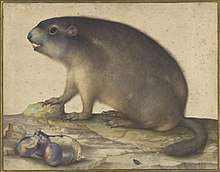
Marmots have been known since antiquity. Research by the French ethnologist Michel Peissel claimed the story of the "Gold-digging ant" reported by the Ancient Greek historian Herodotus, who lived in the fifth century BCE, was founded on the golden Himalayan marmot of the Deosai Plateau and the habit of local tribes such as the Brokpa to collect the gold dust excavated from their burrows.[18]
An anatomically accurate image of a marmot was printed and distributed as early as 1605 by Jacopo Ligozzi who was noted for his images of flora and fauna.
The etymology of the term "marmot" is uncertain. It may have arisen from the Gallo-Romance prefix marm-, meaning to mumble or murmur (an example of onomatopoeia). Another possible origin is post-classical Latin, mus montanus, meaning "mountain mouse".[19]
Beginning in 2010, Alaska celebrates February 2 as "Marmot Day", a holiday intended to observe the prevalence of marmots in that state and take the place of Groundhog Day.[20]
Examples of species
%2C_Yosemite_NP_-_Diliff.jpg)
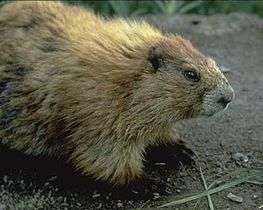 Olympic marmot (Marmota olympus)
Olympic marmot (Marmota olympus)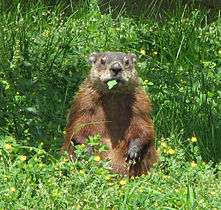
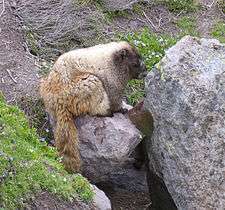 Hoary marmot (Marmota caligata), Mount Rainier National Park
Hoary marmot (Marmota caligata), Mount Rainier National Park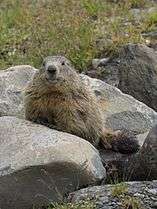
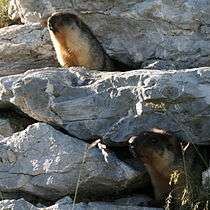 Black-capped marmot (Marmota camtschatica)
Black-capped marmot (Marmota camtschatica)- Long-tailed marmot (Marmota caudata), Pakistan
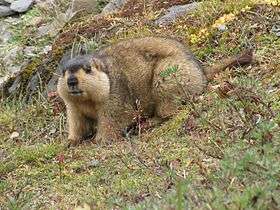 Himalayan marmot (Marmota himalayanus), Bhutan
Himalayan marmot (Marmota himalayanus), Bhutan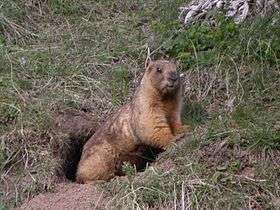
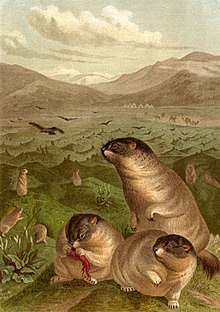 Drawing of bobak marmot (Marmota bobak)
Drawing of bobak marmot (Marmota bobak)
References
- Kryštufek, B.; B. Vohralík (2013). "Taxonomic revision of the Palaearctic rodents (Rodentia). Part 2. Sciuridae: Urocitellus, Marmota and Sciurotamias". Lynx, N. S. (Praha). 44: 27–138.
- Armitage, K. B., Wolff, J. O., & Sherman, P. W. (2007). Evolution of sociality in marmots: it begins with hibernation (pp. 356-367). Chicago, Illinois: University of Chicago Press.
- Cardini, A., & O'Higgins, P. A. U. L. (2004). Patterns of morphological evolution in Marmota (Rodentia, Sciuridae): geometric morphometrics of the cranium in the context of marmot phylogeny, ecology, and conservation. Biological Journal of the Linnean Society, 82(3), 385-407.
- Armitage, K. B., & Blumstein, D. T. (2002). Body-mass diversity in marmots. Holarctic marmots as a factor of biodiversity. ABF, Moscow, 22-32.
- Edelman, A. J. (2003). Marmota olympus. Mammalian Species, 2003(736), 1-5.
- Armitage, K. B., Downhower, J. F., & Svendsen, G. E. (1976). Seasonal changes in weights of marmots. American Midland Naturalist, 36-51.
- Barash, David P. (1989). Marmots: Social Behavior and Ecology. Stanford, California: Stanford University Press. ISBN 978-0-8047-1534-8.CS1 maint: ref=harv (link)
- Hubbart, J. A. (2011). Current Understanding of the Alaska Marmot (Marmota broweri): A Sensitive Species in a Changing Environment. Journal of Biology and Life Sciences, 2(2), 6-13.
- Murdoch, J. D., Munkhzul, T., Buyandelger, S., Reading, R. P., & Sillero-Zubiri, C. (2009). The Endangered Siberian marmot Marmota sibirica as a keystone species? Observations and implications of burrow use by corsac foxes Vulpes corsac in Mongolia. Oryx, 43(3), 431-434.
- Chaudhary, V., Tripathi, R. S., Singh, S., & Raghuvanshi, M. S. (2017). Distribution and population of Himalayan Marmot Marmota himalayana (Hodgson, 1841)(Mammalia: Rodentia: Sciuridae) in Leh-Ladakh, Jammu & Kashmir, India. Journal of Threatened Taxa, 9(11), 10886-10891.
- Armitage, K. B. (1999). Evolution of sociality in marmots. Journal of Mammalogy, 80(1), 1-10.
- Nedergaard, J., & Cannon, B. (1990). Mammalian hibernation. Philosophical Transactions of the Royal Society of London. B, Biological Sciences, 326(1237), 669-686.
- Thorington, R. W., Jr., and R. S. Hoffman. (2005). "Family Sciuridae". Mammal Species of the World: A Taxonomic and Geographic Reference, pp. 754–818. D. E. Wilson and D. M. Reeder, eds. Johns Hopkins University Press, Baltimore.
- Brandler, OV (2003). "On species status of the forest-steppe marmot Marmota kastschenkoi (Rodentia, Marmotinae)". Zoologičeskij žurnal (in Russian). 82 (12): 1498–1505.
- GBIF Secretariat. "Marmota arizonae GBIF Backbone Taxonomy". Retrieved 30 April 2017.
- Paleobiology Database. "Marmota minor". Retrieved 30 April 2017.
- GBIF Secretariat. "Marmota vetus GBIF Backbone Taxonomy". Retrieved 30 April 2017.
- Peissel, Michel. "The Ants' Gold: The Discovery of the Greek El Dorado in the Himalayas". Collins, 1984. ISBN 978-0-00-272514-9.
- "Marmot". Oxford English Dictionary (3rd ed.). Oxford University Press. September 2005. (Subscription or UK public library membership required.)
- The Associated Press. "Alaska to Celebrate its First Marmot Day" Archived 2010-02-05 at the Wayback Machine, Fairbanks Daily News-Miner. Feb. 1, 2010. Accessed Feb. 1, 2010.
External links
| Wikimedia Commons has media related to: |